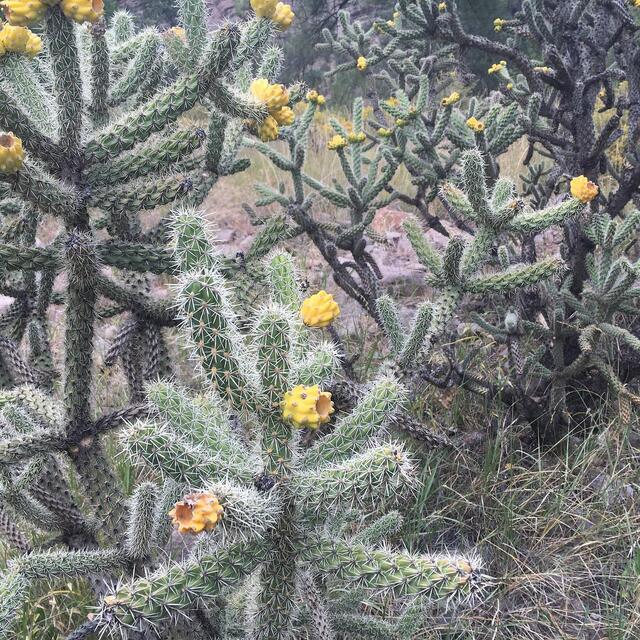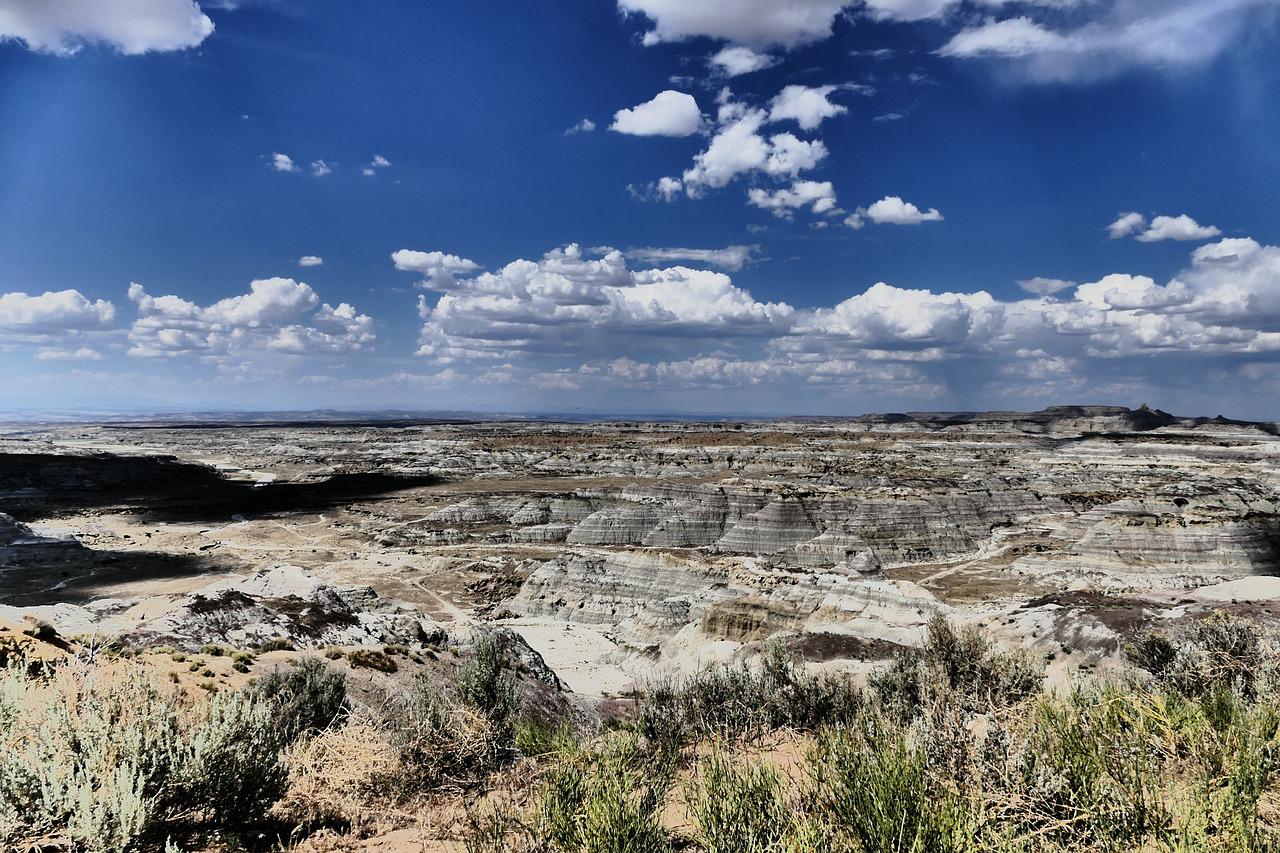Despite it commonly depicted as a land of desert full of cactuses, New Mexico has one of the most diverse landscapes out of all the states. You will see everything from the auburn-colored deserts and broken mesas to the wide-open grasslands and snow-capped mountain peaks. They even have a few extinct volcanoes here. With that in mind, cactus life is just as diverse here, and you have 38 cactus species in New Mexico.
Types of Cactus in New Mexico
We put together this helpful table about the cacti of New Mexico to help you to better understand each species. This is an extensive list, and we don’t expect anyone to look at everything all at once, but it can give you the necessary information for each cactus if you have any questions.
Keep in mind, when we talk about the range, we’re only covering New Mexico to simplify the information, but you can find some of the cacti in other states:
| Common Name | Common Range | Habitat |
| Horse crippler | Southeast New Mexico | Grasslands, scrublands, deserts flats |
| Smallflower fishhook cactus | Northwest New Mexico | Canyons, grasslands, sandstone plateaus |
| Night-blooming cereus | Southwest New Mexico | Grasslands, scrublands |
| Mountain ball cactus | North New Mexico | Pinyon-juniper woodland, grasslands, elevation up to 11,000 feet |
| Plains prickly pear | Middle to high-range new Mexico | Woodlands, hillsides, grasslands |
| Tulip prickly pear | Throughout New Mexico | Canyons, scrublands, grasslands |
| Purple prickly pear | South New Mexico | Well-drained sand and gravel soils |
| Texas prickly pear | Southeast New Mexico | Woodlands, grasslands |
| Brittle prickly pear | East New Mexico | Chihuahua desert, scrublands, limestone hills |
| Barbary fig | Throughout New Mexico | Gravely flats, scrublands |
| Mojave prickly pear | Northwest New Mexico | Joshua tree communities, scrublands, pinyon-juniper woodland |
| Pancake prickly pear | Southwest New Mexico | Mountain foothills, rocky slopes, scrublands |
| Heyder pincushion cactus | Many parts of New Mexico | Grassland, scrubland |
| Arizona fishhook cactus | Southwest New Mexico | Grassland, scrubland |
| Graham’s cholla cactus | South New Mexico | Dry washes, sandy plains, gravel flats |
| Devil cholla | Southwest New Mexico | Scrublands, desert flats, hillsides that reach to 4,000 feet |
| Club cholla | Central and Northwest New Mexico | Pinyon-juniper woodlands, grasslands, hillsides |
| Arizona barrel cactus | Southwest New Mexico | Gravel or sand plains |
| Texas barrel cactus | South New Mexico | Limestone cliffs and hillsides |
| Common beehive cactus | Throughout New Mexico | All environments up to 8,500 feet |
| Cob beehive cactus | South New Mexico | Pine-oak woodland, scrubland, grasslands |
| Nylon hedgehog cactus | North and West New Mexico | Prairies, grasslands, Chihuahuan desert plains |
| Claret cup cactus | Throughout New Mexico | Sandy deserts, grasslands, gravel slopes, canyon sides |
| Strawberry hedgehog cactus | Chihuahuan deserts | Rocky and gravelly slopes, sunny areas |
| Arizona rainbow cactus | Southwest New Mexico | Canyon walls, arid grasslands, rocky hillsides |
| Lace hedgehog cactus | East New Mexico | Chihuahuan desert grasslands, pine and oak woods, scrublands |
| Fendler’s hedgehog | Central and East New Mexico | Bushy plateaus, hillsides, woodlands, grasslands |
| Robust hedgehog cactus | Southwest New Mexico | Hillsides, scrublands, rocky deserts |
| Green strawberry hedgehog | South New Mexico | Scrublands, low elevation areas, open areas |
| Texas rainbow cactus | South New Mexico | Canyon sides, grassy plains, scrublands, limestone terraces |
| Brown flowered cactus | South New Mexico | Prefers full sun, gravely slopes |
| Arizona claret cup cactus | Southwest New Mexico | Scrublands, grasslands, limestone canyons |
| Whipple cholla | West New Mexico | Woodlands, grasslands, scrublands |
| Cane cholla | West New Mexico | Desert plains, grasslands |
| Christmas cholla | Throughout New Mexico | Canyon sides, scrublands, grasslands |
| Tree cholla | Throughout New Mexico | Hillsides, scrublands, woodlands, grasslands |
| Robust spine beehive cactus | Scattered in areas throughout New Mexico | Dry washes, grasslands, scrublands |
| Nipple beehive cactus | Southeast New Mexico | Hillsides and gravelly flats |
Most Common Cactus in New Mexico

In terms of cholla cactus species, the cane cholla, also known as the tree cholla, is the most common cholla here. Some have even interestingly named it the chainlink cactus—picture that! This tree-like cactus has the potential to grow up to 8 feet tall and has spiny, fleshy stems. When the plant dies, it looks like a woody skeleton.
You can see this cactus wild at Petroglyph National Monument and White Sands National Park. Especially when it flowers, it becomes one of the most beautiful plants in the desert. The best time to see them flower is from April to June. Most chollas will bloom once a year, and you can usually see the flower for two to three days.
After it flowers, it produces a conical yellow fruit. While the fruits are edible, the plant is covered in spines requiring some heavy preparation if you wanted to eat it. Most people only consider it a survival fruit because you waste more time and energy preparing than what you get out of it for its small size.
The other danger comes from this one’s reputation for its painful spines making the fruit less worth the effort unless you were in a dire situation.
Along with being common in New Mexico, it can be found as a native species throughout the American Southwest. In the past, Native American tribes would harvest the fruit to eat it raw, stew it or ground it into flour. Whenever the cholla dies, it creates this elaborate pattern of wood that has become popular in furniture.
In case you’d like to see the process of processing dead cholla wood and what it looks like, check it out here:
If you’d like an interesting plant holder made out of cholla wood, we’d recommend going with the Cholla Air Plant Holder. Check it out and see how unique it looks. Another bonus is that they made it in the USA. It serves as a great conversation-starter piece in the home for anyone who has never seen cholla wood before.
Cane cholla are the largest cacti in New Mexico, and if you wanted to see the biggest cane cholla, we would recommend checking out White Sands National Park. The cane cholla has the potential to grow between 3 to 5 feet tall, and it will live for roughly 20 years.
Where Would You Look for Cactus in New Mexico?
If you want to see cactus in New Mexico, you need to know where to look to have the best results. Come especially in the late spring to early summer season to see the cactus light up the desert with their blooms. The northern part of New Mexico is probably one of the worst areas to find cactus. You can find some cholla, prickly pear and other small cacti growing in Taos and Santa Fe, but it doesn’t have as many opportunities as in the southern parts of New Mexico. You may see some but not as many.
A large part of the northern regions of New Mexico is either forest or high desert. Check more in the desert areas for the best opportunities. One time passing through the grassland parts of northeastern New Mexico, I don’t remember seeing any cactus in that area. It was mostly open grasslands, so it depends on where you go in New Mexico, but the deserts will offer you the best opportunities.
Desert Spoon
Right away, the name draws your attention, and they call it this because of its spoon-shaped leaves. This cactus can reach a height of 4 to 5 feet tall in diameter, and at the seven to 10-year mark, it starts to produce flowers. They only flower once every few years, but you can spot a desert spoon easily for its unique appearance. The female plant produces purplish-pink flowers, which have a creamy yellow color.
If you’d like to attract hummingbirds and bees, they love the desert spoon cactus, so you might plant it in your cactus garden. In some cases, you will hear people call it the spoon yucca plant. Keep in mind if you were to take in this plant, it’s a slow grower.
Claret Cup Cactus
Producing some of the most beautiful red flowers, you can find this cactus in the White Sands region of South Central New Mexico. Growing it as a cactus, you have one of the easiest growing cacti around. People have called it several names over the years that include:
- Hedgehog cactus
- Strawberry cactus
- King’s crown cactus
- Spineless hedgehog
- Scarlet Hedgehog cactus
- Kingcup cactus
Along with it growing in New Mexico, you will find this cactus in Arizona and the northern regions of Mexico. Head to the southern regions of New Mexico to the Chihuahuan deserts, and you will find the species commonly growing here. You can often find the claret cup cactus growing at the base of juniper trees in New Mexico since this cactus is an example of one cactus that prefers a little shade.
Some of the other areas where you might look for it in New Mexico include mountain woodlands, rocky slopes and lower desert areas. Claret cup cactus flowers have a nectar chamber inside the base of the flower and the hummingbird has to stick its whole head into the flower to pollinate it.
Many people like to cultivate this cactus because of its beautiful red flowers. In case you’d like to learn more about red cactus flowers, I wrote about a few different types of cactus species that have red flowers here.
Horse Crippler
The horse crippler cactus got its name from its strong spines that lay hidden like a landmine in wait of any creatures that might stand on it. Many horses have been crippled from stepping on it. Commonly found in Big Bend National Park, it remains rare in most other areas. Look in southeast New Mexico for the best results in the state.
This cactus species can tolerate frost well, and its body is twice as wide as it is high. Hence the reason that animals will often stand on it before they see it, including humans. Normally, it only stands 1 to 2 inches above the ground, but it can reach up to 1 foot across. The issue comes from how the grass will often cover it until your horse stands right on it.
I find the pink flowers on this cactus not only beautiful but unique. The flower has a deep red center, and it blooms in the spring of the year. When you take good care of this cactus, it will look stunning in a garden. You want to be aware of where you put it, however, but don’t leave it in an area where it might get covered up so that you would accidentally step on it.
You can see this plant take root in mountain foothills and rocky slopes, but it adapts best to the scrublands of deserts. If you see this plant out in the desert, look at it, but don’t touch it.
You can check out the horse crippler among some other New Mexico cactus species in the video here:
Prickly Pear Cactus
There are seven species of prickly pear cactus in New Mexico. Although to put that into perspective, they have over 200 species of prickly pear cactus, so it’s a broad species with many twists and turns. Let’s have a look at the species that they have in New Mexico.
The plains prickly pear cactus is native to New Mexico, and it has been eaten in both Native American and Mexican dishes. Their fruits have been used in jellies, jams and juices.
The shallow roots of this cactus allow it to capture rainfall easily, and it stores the water throughout the pads of the plant. This cactus can handle the cold better than most species, and because of that, you can find it further north than other species.
Next, you have the tulip prickly pear cactus. The bright and showy flowers of this cactus will eventually develop into a fruit called tunas. This prickly pear prefers the sun, but it can periodically withstand freezes and do fine. In general, this cactus prefers to be hot and dry.

The purple prickly pear cactus has become a popular species for its purple color. In some cases, other cacti can turn purple as well, but it isn’t always a good thing. This one does it naturally, and aside from the color, it looks like a regular prickly pear cactus. The purple prickly pear would make for a great choice to add some color to a cactus garden.
The pancake prickly pear has spines that become blackish as they age. In all honesty, this isn’t one of my favorite cacti in terms of beauty—it doesn’t look good. This cactus, however, can have hundreds of pads that all come from a single trunk. In some cases, you may see no spines on the pancake prickly pear. They have been known to reach heights of up to 8 feet tall. The pads on this one are fast-growing stems, and it’s one of the faster-growing prickly pear cactus species.
Night-Blooming Cereus
If you want to know where to find the night-blooming cereus in New Mexico, check Hidalgo County in southern New Mexico. It’s the southernmost county in all of New Mexico, and it’s a rare and endangered cactus that sometimes occurs in the Chihuahuan desert. Most of the time, this cactus looks like a dead bush, but it has one of the more beautiful flowers when it blooms.
Usually, it will bloom from May to June, but it has gone all the way to October and even later in rare cases. The blooming happens sporadically, rather than continuously. Also, they don’t bloom until they reach maturity at four to five years old.
Unlike some of the other cacti, the night-bloom cereus blooms after dark usually from 8 pm to 9 pm. They wilt before sunrise. The buds will open slowly, and they release a sweet fragrance worth the wait for plant lovers. For new night–blooming cereus, they will usually only produce a couple of flowers for their first time blooming.
In fact, they have several different types of night-blooming cereus, and the species will determine how often and when it will bloom at night.
Devil Cholla
Found in the Chihuahuan desert and southwestern New Mexico, it got its name because of their well-defined tubercles. They’re dagger-sharp as anyone knows who may have been unlucky enough to step on them. In many cases, they appear as simple ground creepers, but you will ruin your day if you step on them.
The spines from this cactus come in all colors, and it has many regional names depending on the area. You will find this plant scattered around in the low elevation regions like the Chihuahuan desert.
In most of New Mexico, you can find the devil cholla even if you don’t see as much of it in certain parts. Cholla in general are some of the most widespread cacti throughout the state.
Do They Have the Saguaro Cactus in New Mexico?
You can find the Saguaro cactus in southern Arizona and western Sonora, Mexico. The cactus cannot be found growing wild in New Mexico since it isn’t native there, but some have found a few stray plants of it in southeast California. All in all, Saguaro only grows in the Sonoran desert, and they only grow in parts of the Sonoran desert.
The Saguaro is, however, common to the Sonoran desert, and the government doesn’t list it as an endangered plant.
Final Thoughts
New Mexico holds 38 species of cactus within the state, and we covered some of the more interesting species within the state. The one that you will find most commonly here is the many species of cholla. If you’d like to see the earliest flowering cactus in Central New Mexico, look for the Chihuahuan Pineapple Cactus. The flowers are mostly white with cream-colored anthers.
If you have any thoughts or comments about the cacti in New Mexico, please free to leave a comment below for open discussion. What’s your favorite cactus in this state?

